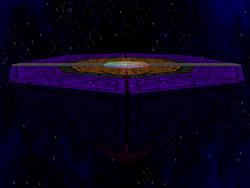Final Destination (SSB)
| Special Stage Final Destination | |
|---|---|
 
| |
| Universe | Super Smash Bros. |
| Appears in | SSB |
| Availability | 1P Game |
Final Destination (終点 Endpoint),[1] also referred to as Master Hand's Residence,[citation needed] is a stage in Super Smash Bros. exclusive to its 1P Game and is not normally playable in Versus Mode. It is the location where the player fights Master Hand, at the end of the 1P Game.
Like its successors in later games, this stage is completely flat. The platform's central design is a yellow, temple-like structure. The background changes depending on Master Hand's HP: it starts out in space with stars visible, then changes into a cloudy area when Master Hand reaches 210 HP, then to a wormhole at 120 HP, and finally the wormhole drastically accelerates at 30 HP.
Accessibility[edit]
In the 1P Game, after the player defeats the Fighting Polygon Team, they are transported to this stage, where they conduct the final battle of the 1P Game against Master Hand. This is the only time Final Destination appears in normal gameplay; it is not accessible in VS Mode.
Hacking[edit]
Final Destination can be accessed by using a cheating device. In order the access it, the player needs to enter a code that makes this stage the only one fought in 1P Game, as the game will freeze if it is accessed normally through the debug menu or with a code to load this stage on the VS Mode stage select menu.
Normally there can only be two players fighting on it at once, as the stage is only designed for one character and Master Hand to be used simultaneously upon it. However, there are cheats that allow this stage to act like VS Mode, which is started up by choosing 1P Game. The game will show that the player is entering the first stage, but starts the match on Final Destination. Using additional cheats, it is possible to allow up to four players, set the number of stocks for each player, and choose the players' characters.
If Player 1 wins, the game shows the 1P Game results screen; if another player wins, the game displays the continue screen. Even among hacked stages, this is the only stage for which this occurs.
There is also a hack that allows the stage to be accessed directly in VS Mode. Normally the stage uses the Master Hand intro music by default, but the hack makes the level load the Master Hand battle music instead. Additionally, the background never changes when accessed this way.
If the stage is hacked to act like VS Mode, then the background will change depending on how much damage player 1 has taken. If player 1 takes 90% damage, the background changes to the clouds; however, if player 1 is KO'd (and thus reset to 0% damage), the background doesn't change back to the stars, it just stays as it was when player 1 was KO'd. If player 1 takes 90% damage again, the background does not change to the wormhole, as the background is set to change when the character reaches a certain point of damage.
If Final Destination is loaded in VS Mode, then the background does not change—it will just stay on the first background without shooting stars. This is because the hack that needs to load a featureless stage's index to prevent the game from crashing (Duel Zone's index is used with the publicly released hack), while Final Destination is the actual stage index. The fix code works by loading the value 0x0E when the actual level index is 0x10. If 0x10 is in the level index variable, the instruction at 0x80104C14 can be replaced so that the level can load properly (since Nintendo 64 games tend to load code into RAM and execute from there). The reason Final Destination crashes when accessed like the other stages is unknown, but it is most likely because the background changes when damage is reached by a defined character.
Nomenclature[edit]
In the game's Japanese website, the stage is called 終点 Shūten.[1] The name is also shared with all other incarnations of Final Destination. In Super Smash Bros. Ultimate, the music from the stage is titled "Final Destination - Super Smash Bros.", following the trend of such stages having the same name as all of its future variants.
Tournament legality[edit]
Unlike all future iterations of Final Destination, this stage is generally banned in competitive play: besides the fact that it needs a hacking device to be accessed, the glitches listed above (such as the game freezing, and the continue screen being displayed if anyone besides player 1 wins) make it undesirable in a tournament setting. However, some tournaments that use specialized rulesets (such as GENESIS 6) allow the stage as a legal counterpick stage for doubles, provided that the glitches have been fixed.
Gallery[edit]
Mario faces Master Hand on Final Destination.
A hacked four player VS match on Final Destination. Metal Mario can also be seen here.
Trivia[edit]
- Super Smash Bros. is the only game in which Final Destination is not a playable stage in VS Mode, as well as the only game in which Final Destination is not named within the game.
- This is the only version of Final Destination where the stage cycle doesn't end with a blackout, instead ending with a whiteout.
External links[edit]
- Music for Final Destination (SSB)
- A video on how to play Final Destination in VS. mode
- The direct way to play Final Destination in VS. mode
References[edit]


